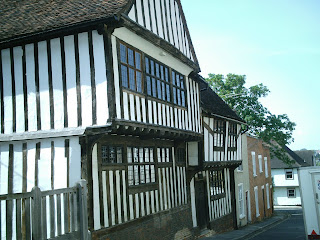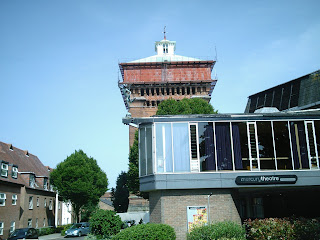 Colchester, the oldest recorded town in England, is an army town, full of fit young men with decent haircuts and today with the sun out proved no exception. The Romans used Colchester as their capital city but soon found London more convenient. It was also home to Old King Cole of nursery rhyme fame, although as he lived long before Sir Walter Raleigh so I suspect the pipe that he called for was a musical one rather than one for Virginia tobacco.
Colchester, the oldest recorded town in England, is an army town, full of fit young men with decent haircuts and today with the sun out proved no exception. The Romans used Colchester as their capital city but soon found London more convenient. It was also home to Old King Cole of nursery rhyme fame, although as he lived long before Sir Walter Raleigh so I suspect the pipe that he called for was a musical one rather than one for Virginia tobacco.The walk from the North Station to the town is long, and not very interesting. You do cross the river which runs at the bottom of the hill that the town is built on and there are some half timbered houses there. The first church I came to, St Peter’s, was open and still contained galleries, the ones in the North Aisle did not reach the arcading, whereas those in the South Aisle did, the whole effect was a little peculiar. The church was nothing special, typical of town churches in many parts of the country, although it is the only church in Colchester mentioned in the doomsday book. There was a little drama in the grounds of St Botolph’s Priory where four policemen went to see some people sitting in the grounds. Don’t know what it was about as I kept away. The ruined priory of St Botolph uses recycled roman bricks in its structure and has a fine Norman doorway, although the new church of St Botolph of 1836 has nothing fine about it from the outside even though it is Romanesque in style. After a bit of wandering and Coöperative and charity shopping – there are some fine shops in Colchester including an East of England Coöperative Department Store – it was time to hit the Colchester Heritage Trail. This led from the castle, which is the largest Norman keep in Europe. It then leads into the Dutch quarter where Flemish weavers settled in the 16th Century. There are lots of half timbered houses here and a tiny church dedicated to St Helen, now used by the Orthodox church. I went in and found myself surrounded by icons and confronted with a large chandelier. The Orthodox have a screen between nave and chancel so could not see the holy table/altar but the church was interesting. It occupied part of the site of the Roman Amphitheatre.
The next church, St Martins, had a person giving a reading of Moby Dick. It’s a shame there was nobody there to listen to him really, but I got a smile. St Martins church is redundant but has some badly preserved wall paintings and a Norman tower all fallen down due to damage during the civil war siege of Colchester. The Royalists held out here.

Colchester has Roman walls and the town heritage trail leads past these, including the Balkerne Gate, the oldest surviving Roman gateway in Britain. In front of this gateway is ‘Jumbo’ a massive brick water tower built in 1882. The builders crafted a weather vane in the shape of an elephant and the name stuck. The mercury theatre proves that not all buildings in Colchester are from medieval times.
Tymperleys, now a clock museum, is most firmly from this era. It is a lovely half timbered house.
The rest of the trail was up a rather boring residential street, but by the castle I met a former work colleague, who had driven up to Colchester to escape house painting. It was good to see him, and most unexpected. By then I was exhausted so went for a drink in the George, which looked very old, but may not have been. Colchester - recommended!
The pictures show St Botolph's Priory, the Balkerne Gate, a 16th Century House in the Dutch Quarter and the Mercury Theatre with Jumbo in the background.





No comments:
Post a Comment